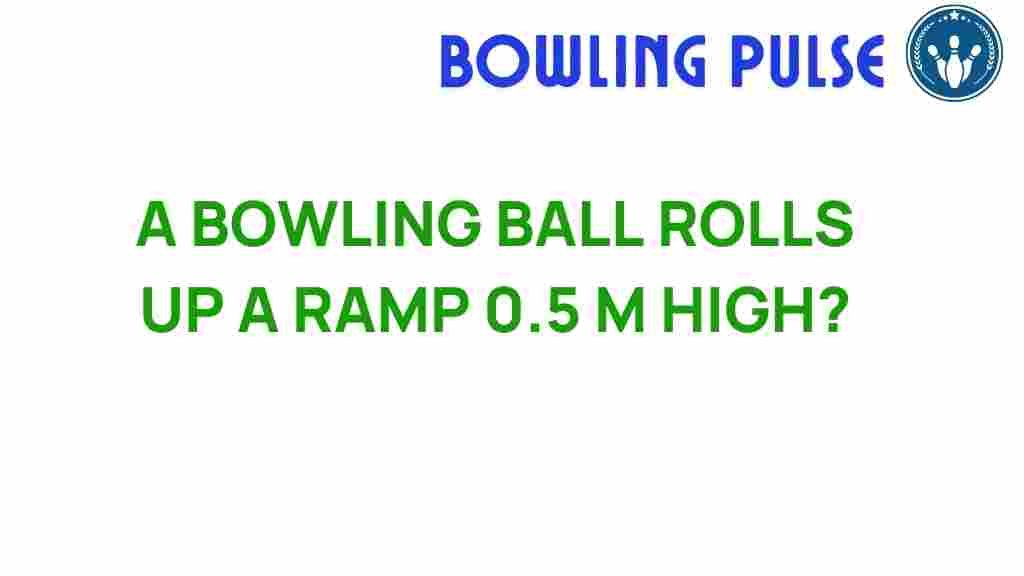The Physics Behind a Bowling Ball’s Ascent: Can It Roll Up a 0.5m Ramp?
Understanding the physics behind everyday activities can be both fascinating and enlightening. One such scenario is the ascent of a bowling ball up a ramp. In this article, we will explore the mechanics of a bowling ball rolling up a 0.5m ramp, examining the energy, gravity, and motion involved. We’ll delve into the principles of sports science and the physics that govern this intriguing situation.
Introduction to the Concepts
The interaction of a bowling ball with a ramp involves several fundamental concepts in physics. To determine if a bowling ball can ascend a ramp of 0.5 meters in height, we must consider:
- Energy: The conversion of kinetic energy to potential energy.
- Gravity: The force pulling the bowling ball down the ramp.
- Motion: The bowling ball’s initial velocity and rolling dynamics.
By analyzing these factors, we can conclude whether or not a bowling ball can successfully roll up the ramp.
Understanding Energy in Motion
At the outset, it’s essential to understand the concepts of kinetic and potential energy. Kinetic energy (KE) is the energy of motion, defined by the equation:
KE = 0.5 * m * v²
where m is the mass of the bowling ball, and v is its velocity. Potential energy (PE), on the other hand, is the energy stored due to an object’s height above a reference point, calculated as:
PE = m * g * h
where g is the acceleration due to gravity (approximately 9.81 m/s²), and h is the height of the ramp.
Setting Up the Ramp Scenario
Imagine a bowling ball at the base of a ramp that rises to a height of 0.5 meters. To determine if the ball can roll up the ramp, we need to analyze the energy conversions taking place.
Step 1: Calculate the Potential Energy at the Top of the Ramp
Assuming the bowling ball has a mass of 7 kg (the standard weight for a bowling ball), we can calculate the potential energy at the top of the ramp:
PE = m * g * h = 7 kg * 9.81 m/s² * 0.5 m = 34.335 J (Joules)
Step 2: Analyze the Kinetic Energy Required
For the bowling ball to ascend the ramp, its initial kinetic energy must be equal to or greater than the potential energy required to reach the height of 0.5 meters.
Step 3: Determine the Velocity Needed
Using the kinetic energy formula, we set KE equal to the calculated potential energy:
0.5 * m * v² = 34.335 J
Substituting the mass of the bowling ball:
0.5 * 7 kg * v² = 34.335 J
Solving for v:
v² = (34.335 J) / (0.5 * 7 kg) = 9.81
v = √9.81 ≈ 3.13 m/s
This indicates that the bowling ball must have an initial velocity of at least 3.13 m/s to reach the height of 0.5 meters on the ramp.
The Role of Gravity in the Bowling Ball’s Motion
Gravity plays a crucial role in the motion of the bowling ball as it moves up the ramp. When the ball rolls up the incline, gravity acts against its motion, causing it to decelerate. The steeper the ramp, the greater the gravitational force opposing the ascent. This means that if the initial kinetic energy is insufficient, the ball will not reach the top of the ramp.
Factors Affecting the Bowling Ball’s Ascent
Several factors can influence whether a bowling ball can successfully roll up a ramp:
- Initial Velocity: The speed at which the bowling ball starts its ascent.
- Ramp Angle: The incline of the ramp affects the gravitational force acting on the ball.
- Friction: The friction between the ball and the ramp surface can reduce the ball’s kinetic energy.
To optimize the chances of the bowling ball reaching the top, consider the following:
Step 4: Assessing Friction and Surface Conditions
The surface of the ramp can significantly affect the bowling ball’s ability to ascend. A smooth surface will minimize friction, allowing for better motion. In contrast, a rough surface will increase friction, requiring a higher initial velocity to overcome this resistance.
Troubleshooting Tips
If you find that the bowling ball is not rolling up the ramp as expected, consider the following troubleshooting tips:
- Check the Initial Speed: Ensure that the bowling ball is released with adequate velocity.
- Inspect the Ramp Surface: Make sure the ramp surface is smooth to reduce friction.
- Adjust the Ramp Angle: A gentler slope may help the bowling ball ascend more easily.
Conclusion: Can the Bowling Ball Roll Up the Ramp?
In summary, a bowling ball can roll up a 0.5-meter ramp if it has an initial velocity of at least 3.13 m/s. This analysis reflects the fundamental principles of physics, where energy, gravity, and motion interact in sports science. By understanding these mechanics, one can better appreciate the dynamics involved in seemingly simple activities like bowling.
For those interested in further exploring the fascinating world of physics in sports, consider visiting this resource for more detailed insights.
Additionally, if you’re eager to dive deeper into the principles of motion and energy, check out this article on related topics.
Whether you’re a physics enthusiast or a sports lover, understanding the mechanics behind a bowling ball’s ascent can enhance your appreciation for both disciplines.
This article is in the category Techniques and created by BowlingPulse Team
